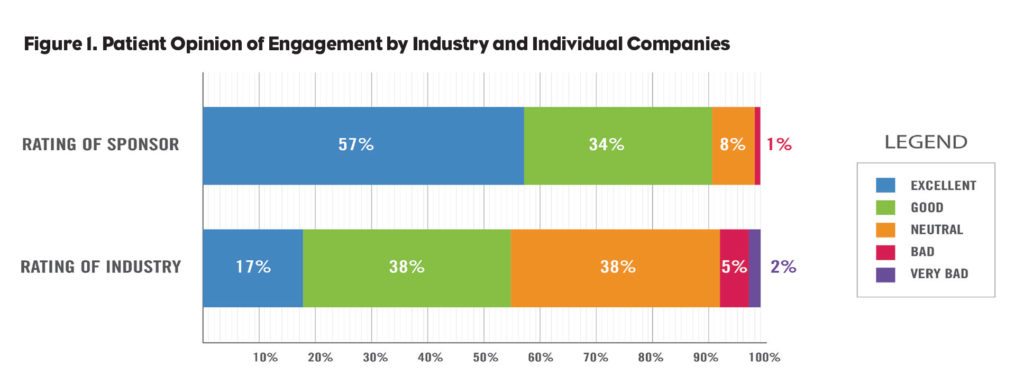One of the biggest myths about patient centricity is to think of it as simply “corporate social responsibility”—a charitable act that companies voluntarily do for others with little to no benefit to themselves. I argue that patient centricity and patient engagement are essential bread and butter functions that allow all other parts of the operation to come to full fruition.
My father is the ultimate entrepreneur. He got his first business license as an 8-year-old in order to sell ice cream to the factory workers in his small Ohio town. This is the man I learned so much from, and he always said: “People like to do business with people they like.” That’s because liking and trusting someone goes hand in hand. How likely are you to do business with someone you don’t trust? In life science, we should ask ourselves: Have we earned our trust? It’s cheap to always just point at the bad apples or to seek excuses for why things are the way they are. Individual companies can make a difference for themselves and for the whole industry, and many of them really do.
A good illustration of this comes from a survey we conducted with 1,262 patients and caregivers who are actively engaged with industry partners. Among those respondents, more than half have a favorable opinion of the life science industry overall—which is in stark contrast to other studies that survey the general patient population. And more than 90% of the respondents view the individual company favorably that actively engages with them.
 In the Absence of Information: Misinformation
In the Absence of Information: Misinformation
Pharma marketing without patient engagement is like a car without wheels: You won’t go very far on today’s patient superhighway. All of what our industry does would be completely irrelevant without patients. And life science companies are realizing the importance of engaging more with patients. Patients today are more involved in decision-making together with their doctor, they carry more responsibility, and they have more information resources at their disposal. When I was diagnosed with MS, I would have had to go to the local library to find any info on my disease. That was the only way to begin my fact-finding mission. Today, most patients first search online, regardless of the credibility of what they find there. If we’re not engaged with patients online and off, others will be, and there is no reason to assume that those others will provide the patients with info that’s accurate, vetted, and credible.
“In the absence of information, there’s misinformation,” said one of the panelists on a workshop that we conducted at eyeforpharma’s Patient Summit USA last month. Misinformation is not just inherently dangerous; it can kill a reputation. As Warren Buffet once famously said: “It takes 20 years to build a reputation and five minutes to ruin it.” Every time it looks like finally our industry is on the way to making things better, a rogue CEO at the helm of some company pops up, commands the limelight for five minutes, and “poof!”—the 20 years start counting from zero again. But all pharma companies are not created equal: Every individual company can choose to stand out as a shining example of how it should be done, and if all companies put patients first, the industry as a whole will eventually be better off.
The Responsibility to Listen
The more trust there is, the more comfortable you are to invest more in the relationship. And the closer the relationship is, the easier you can grow the trust. It’s a virtuous circle. I remember at eyeforpharma’s Barcelona conference earlier this year, the chairman Paul Simms likened the patient-pharma relationship to relationships we have at home with our spouses, using the hash tag #lovepharma. Now you might think “love” in this context is putting it on a bit thick. But the thinking is right: All of us are in multiple relationships, some of those are love relationships, some are purely transactional, and most fall somewhere in-between on this spectrum. If your business depends on long-term commitments, you’ll always be more productive the closer you are to the person you’re doing business with. If you’re only transactional, you won’t gain much trust or customer loyalty.
In other words: It would be a mistake to perceive patient centricity purely as a charitable exercise. We don’t just need to be nice to patients in order to look ourselves in the mirror. We need to do it in order to run our businesses effectively. Why do companies in all industries conduct market research and ask their customers for feedback? We have a responsibility to listen and to act on what we learn.
Becoming Relevant Through Two-way Dialogue
We can listen to patients in many ways, and the level of involvement varies greatly: From simply collecting information on the Internet to actively conducting a two-way dialog with patients in live settings. I like to recommend the more involved, more active, more in-person approaches whenever possible. They allow us to make a connection, to become relevant in the patient’s journey, to—literally and figuratively—help patients write their story and contribute in a meaningful way to their experiences.
Patient centricity, guaranteed through patient engagement, is both: An end in itself and a means to an end. Whichever way you look at it, if we want to pour our marketing resources into things that will move the needle, we’ll want to pour them into patient-centered activities. The successful ones in our industry do this. It’s their way of ensuring that their customers get to do business with people they like.





